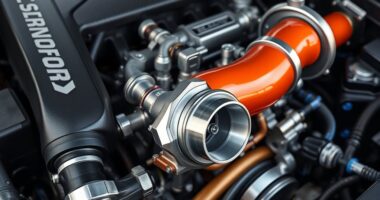With AVCS cam timing optimization, you’ll quickly feel a smoother, more responsive engine. It adjusts valve timing in real time, improving power delivery during acceleration and making idling quieter. This system also boosts fuel efficiency and reduces emissions, giving you a more eco-friendly drive. Plus, it helps keep your engine in excellent condition, minimizing repairs over time. Keep going to discover how this technology can transform your driving experience even further.
Key Takeaways
- Experience smoother acceleration and more responsive throttle due to optimized valve timing adjustments.
- Feel improved engine responsiveness during low-speed and high-speed driving conditions.
- Notice enhanced power delivery and torque when AVCS advances or retards cam timing.
- Enjoy quieter engine operation with reduced vibrations from precise valve control.
- Benefit from better fuel efficiency and reduced emissions, contributing to an environmentally friendly drive.

Variable Valve Timing Control (AVCS) plays a crucial role in enhancing engine performance, fuel efficiency, and emissions. When it comes to valve control, AVCS adjusts the timing of the opening and closing of your engine’s valves, ensuring they operate at the most effective points throughout different driving conditions. This precise control means your engine breathes better, delivering power when you need it and conserving fuel when you don’t. You can feel these improvements in everyday driving—more responsive acceleration, smoother idling, and better overall efficiency.
By actively managing valve timing, AVCS helps balance power output and fuel consumption. During low-speed driving or idling, it delays valve opening to minimize fuel wastage, leading to improved fuel efficiency. When you accelerate or need more power, AVCS advances valve timing for quicker air intake and exhaust, providing the performance boost you feel behind the wheel. This seamless adjustment ensures your engine isn’t wasting fuel during less demanding conditions, which means fewer trips to the pump and more miles from each tank.
The real benefit of AVCS is in how it fine-tunes valve control without requiring manual adjustments. It uses sensors and a control unit to continuously monitor engine load, speed, and temperature, then makes real-time adjustments. As a result, your engine operates more efficiently across a range of speeds and loads. You’ll notice that your vehicle responds more promptly and smoothly, especially during sudden acceleration or deceleration. Plus, because the system optimizes combustion, it reduces emissions, making your drive more environmentally friendly. AI security measures in automotive technology are advancing to ensure these systems remain safe from vulnerabilities.
Another aspect you’ll appreciate is how AVCS contributes to engine longevity. Proper valve timing reduces stress on engine components by preventing knocking and excessive wear. This not only keeps your engine running cleaner but also extends its lifespan. When valve control is finely tuned, your engine runs cooler and smoother, which translates to less maintenance and fewer repairs over time. The system’s ability to adapt to different driving conditions means your engine remains in excellent shape longer, providing consistent performance you can trust.
Frequently Asked Questions
How Does AVCS Improve Fuel Efficiency?
Variable valve timing systems like AVCS improve fuel efficiency by adjusting the cam timing to optimize engine performance based on driving conditions. You benefit by experiencing better throttle response and reduced fuel consumption. When the system advances or retards the valve timing, it guarantees the engine operates more efficiently, especially at different speeds. This dynamic adjustment helps you save fuel while maintaining power, making your driving smoother and more economical.
Can AVCS Tuning Cause Engine Damage?
Sometimes, tuning your AVCS cam timing feels like a perfect coincidence, but if you don’t get it right, it can cause engine damage. Incorrect adjustments to valve overlap or cam phasing can lead to poor combustion, increased wear, or valve damage. Always guarantee your tuning is precise and within manufacturer specs to prevent harm. Proper calibration maintains engine health while maximizing performance benefits.
Is AVCS Cam Timing Adjustable on All Vehicles?
Not all vehicles have adjustable timing for their variable cam systems. If your car features an AVCS or similar technology, it might have an adjustable cam timing feature, but many models don’t. You’ll need to check your vehicle’s specifications or consult a mechanic to see if your engine’s variable cam system is adjustable. If it is, tuning can optimize performance; if not, modifications could cause damage.
How Does AVCS Affect Engine Noise Levels?
You’ll find that AVCS actively alters valve operation, which can substantially influence engine noise levels. When AVCS adjusts cam timing, it promotes smoother operation, leading to noise reduction, especially at idle and cruising speeds. You might notice quieter, calmer engine sounds because optimized valve timing minimizes vibrations and harshness. Overall, AVCS helps create a more peaceful and pleasant driving experience by fine-tuning valve operation and reducing unwanted noise.
What Are the Signs of AVCS System Failure?
If your AVCS system fails, you might notice increased valve noise and higher oil consumption. The engine could run rough or stall, and you may see a drop in fuel efficiency. Check for warning lights on your dashboard, and listen for unusual rattling sounds. These signs indicate that the system isn’t properly adjusting cam timing, which can lead to more significant engine issues if left unaddressed.
Conclusion
Optimizing your AVCS cam timing can truly transform your driving experience, making your engine more responsive and efficient. Remember, a well-tuned engine is like a well-told story—every part must work harmoniously. By fine-tuning your cam timing, you’re not just improving performance; you’re ensuring longevity and reliability. As the saying goes, “A stitch in time saves nine,” so take the time to optimize now and enjoy smoother, more powerful rides ahead.









